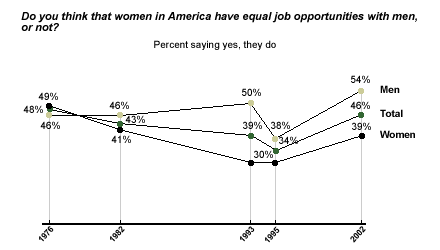The gender gap in working wages has long been a rallying point for groups devoted to the advancement of equality between genders. Overall, 2000 Census figures show that women earn 73 cents for every dollar that men take home, not considering differences in education or experience. Taking experience and education into account brings the current differential to 81 cents to the dollar. While this is far from dollar-for-dollar economic parity, it is a major improvement from the pay inequality women experienced three decades ago. The Employment Policy Foundation estimates that women earned just 59 cents for each dollar men earned in the 1970s.
Perceptions of Inequality
Many would argue that the ongoing tendency to relegate women to "secondary" social roles, particularly in the workplace, is to blame for this pay differential. A Gallup poll conducted in June 2002* reveals that perceptions of how women are treated in society differ considerably by gender. Thirty-four percent of men** are very satisfied with the way women are treated in society, compared to only 18% of women***. A similar gap exists when it comes to opinion on equality in the workplace. A majority of men (54%) feel that women have equal job opportunities with men, as do only 39% of women. In other words, most women perceive a job parity problem, while most men do not.
Few would disagree that women face fewer obstacles to equal employment in 2002 than they did back in 1976, and yet a cursory glance at the public opinion numbers during those years might misleadingly suggest that there has been little change. In 1976, 48% of Americans overall said that women have equal job opportunities with men, while a statistically indistinguishable 46% said so in 2002. This may seem to suggest that job equality hasn't improved, but it could also reflect improving job equality (driving percentages upward) in combination with greater awareness of the issue (driving percentages downward). The most blatant glass ceilings and other workplace inequalities may have been removed since the 1970s, but women today also have higher expectations for equality now than they did 25 years ago. Perceptions of gender equality declined among women after 1976, concurrent with a high-profile push by the National Organization for Women in the late 1970s and early '80s to ratify an Equal Rights Amendment. But a rapid rise in recent years suggests that Americans now perceive forward progress.

It is important to note that, whereas very similar percentages of men and women perceived gender-based inequality a quarter-century ago, the numbers have since diverged significantly. Whereas men in 2002 are more likely to perceive that women have equal opportunities on the job than they were in 1976 (up to 54% from 46%) women have moved in the opposite direction in their thinking on this issue. The percentage of women who think that women have equal opportunities is currently down to 39% from 49% in 1976. Whether this trend reflects changing awareness or changing opportunities, the increased self-awareness of women as a social and political group have permanently changed the way Americans think about the workplace. Nevertheless, three out of five women still feel progress needs to be made.
Key Points
The differences between male and female perceptions of the status of women in the workplace may relate to discrimination that women have personally experienced in their own lives. Nineteen percent of women say they feel discriminated against in public life or employment at least once a month, and 41% of women say they feel discriminated against at least a few times a year. Because many of these instances of gender discrimination may relate to obtaining jobs, equal pay or promotions, they may contribute to the gap between the ways that men and women perceive gender equality. These perceptual differences, as well as the disparity in pay between men and women, indicate that, despite perceptions of progress in recent years, there is still a long way to go in the march toward equality in the workplace.
*Results are based on telephone interviews with 1,360 national adults, aged 18 and older, conducted June 3-9, 2002, including oversamples of Blacks and Hispanics that are weighted to reflect their proportions in the general population. For results based on the total sample of national adults, one can say with 95% confidence that the maximum margin of sampling error is ±3%.
**Results for the sample of 623 men, aged 18 and older, are based on telephone interviews conducted June 3-9, 2002. For results based on the total sample, one can say with 95% confidence that the margin of sampling error is ±4%.
***Results for the sample of 737 women, aged 18 and older, are based on telephone interviews conducted June 3-9, 2002. For results based on the total sample, one can say with 95% confidence that the margin of sampling error is ±4%.
